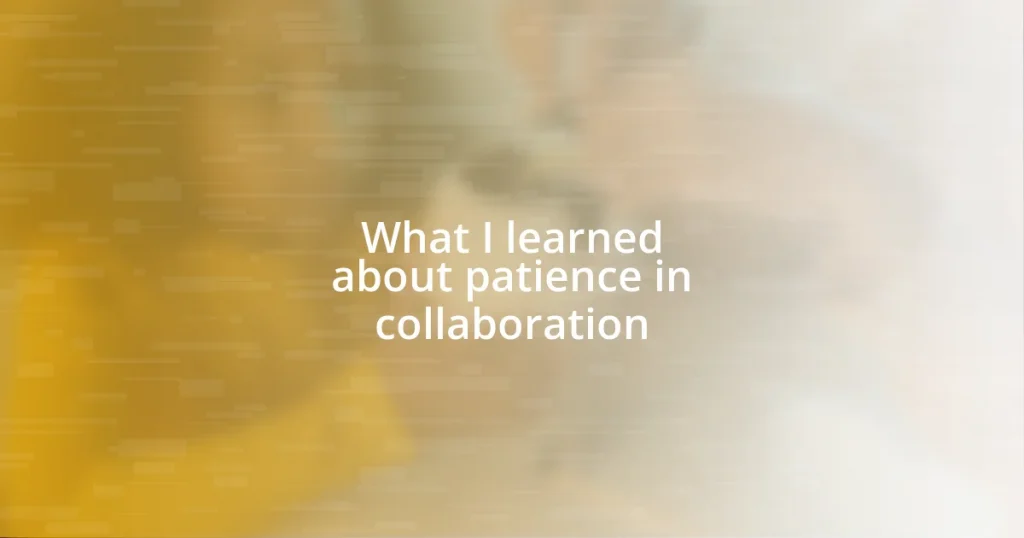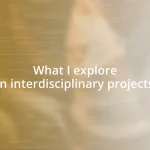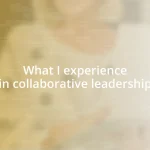Key takeaways:
- Patience fosters creativity and deeper connections within teams, turning conflict into collaboration through understanding and reflection.
- Recognizing personal triggers enhances collaboration; self-awareness and empathy can significantly improve team dynamics and communication.
- Implementing active listening techniques creates a supportive environment that encourages open dialogue, trust, and appreciation among team members.
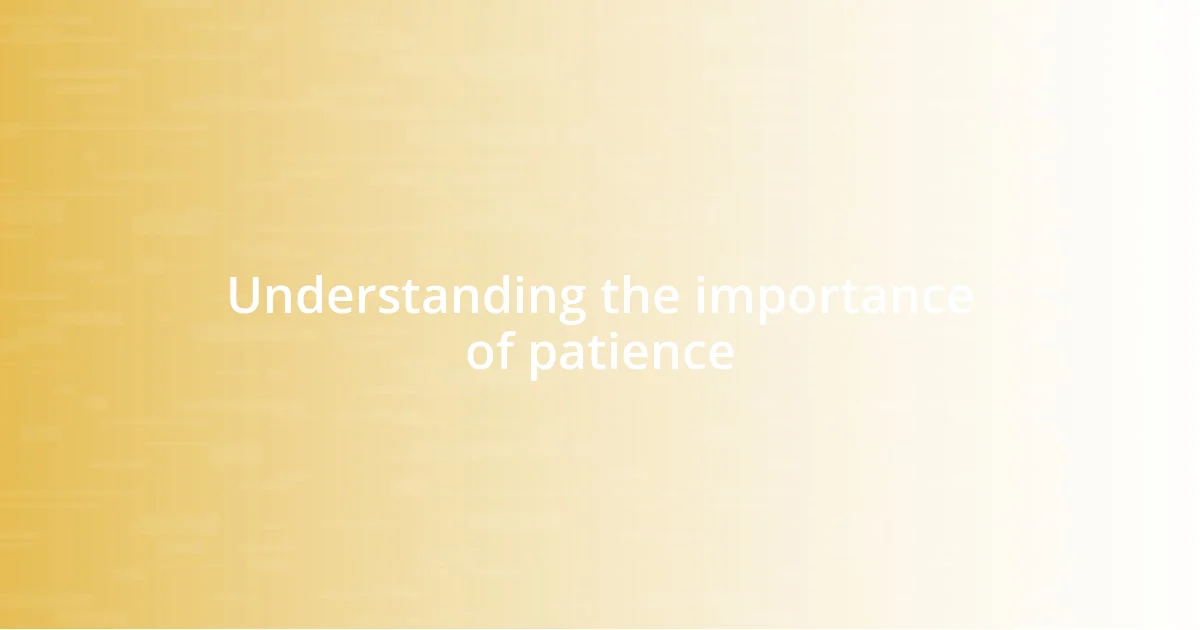
Understanding the importance of patience
In my experience, patience is often the overlooked cornerstone of effective collaboration. I remember a project where we were racing against the clock. Instead of pushing through with frustration, I took a step back and allowed team members to vocalize their thoughts. This instant shift in energy taught me that when we’re patient, creativity has the space to flourish.
When I think back to that time, I realize how essential it is to give others the room to express their ideas. Have you ever felt the pressure to have an immediate solution, only to realize that a slower approach yielded better results? In moments of deliberation, connections deepened, and the team bonded over shared struggles and triumphs.
Additionally, patience cultivates an environment where mistakes can be embraced, not feared. I recall a misstep during a collaborative meeting that initially caused tension. However, by allowing everyone to reflect on the error rather than rushing judgment, we collectively gained insights that propelled our project forward. It’s quite fascinating how patience can transform conflict into collaboration, wouldn’t you agree?
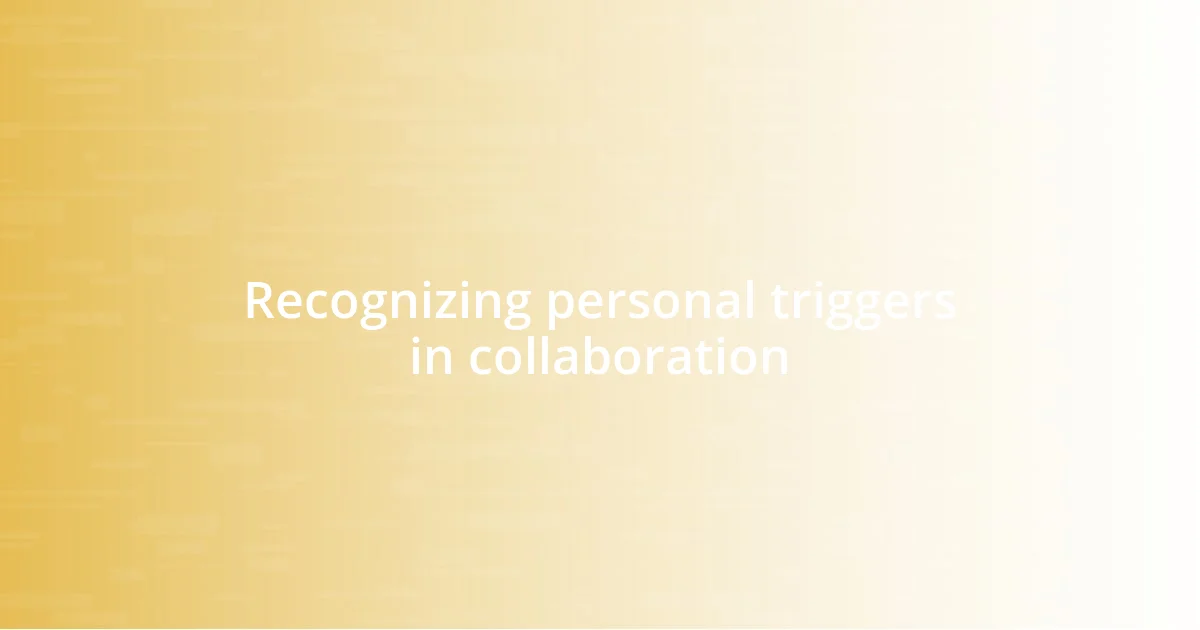
Recognizing personal triggers in collaboration
Recognizing personal triggers is vital for effective collaboration. I’ve noticed that certain situations can trigger my frustration, often when deadlines loom or when communication breaks down. One time during a project, I felt my impatience rise when someone continually misinterpreted my ideas. It was a real eye-opener for me to realize that instead of blaming them, I needed to assess why this triggered my reaction. Reflecting on my emotions helped me understand my own expectations better and adapt my approach.
On another occasion, during a brainstorming session, I recognized a pattern: whenever a colleague challenged my ideas, my defensive trigger would activate. This awareness was pivotal. Instead of reacting impulsively, I learned to take a deep breath and ask clarifying questions. It’s astonishing how simply taking a moment to reframe my thoughts could reduce the tension in the room, allowing for a more open exchange of ideas. Have you found similar moments where self-awareness changed the outcome of a discussion?
Finally, it’s important to consider the atmosphere around us. I once worked on a team where past grievances often resurfaced during meetings. Understanding how these collective memories could trigger our emotions was crucial. I remember actively listening to my teammates’ concerns, which encouraged them to express themselves freely without fear of judgment. By practicing patience and empathy, I found that we could transform these triggers into opportunities for deeper understanding and collaboration.
| Triggers | Responses |
|---|---|
| Impatience during discussions | Practice active listening |
| Defensiveness when challenged | Ask clarifying questions |
| Resurfacing past grievances | Encourage open expression |
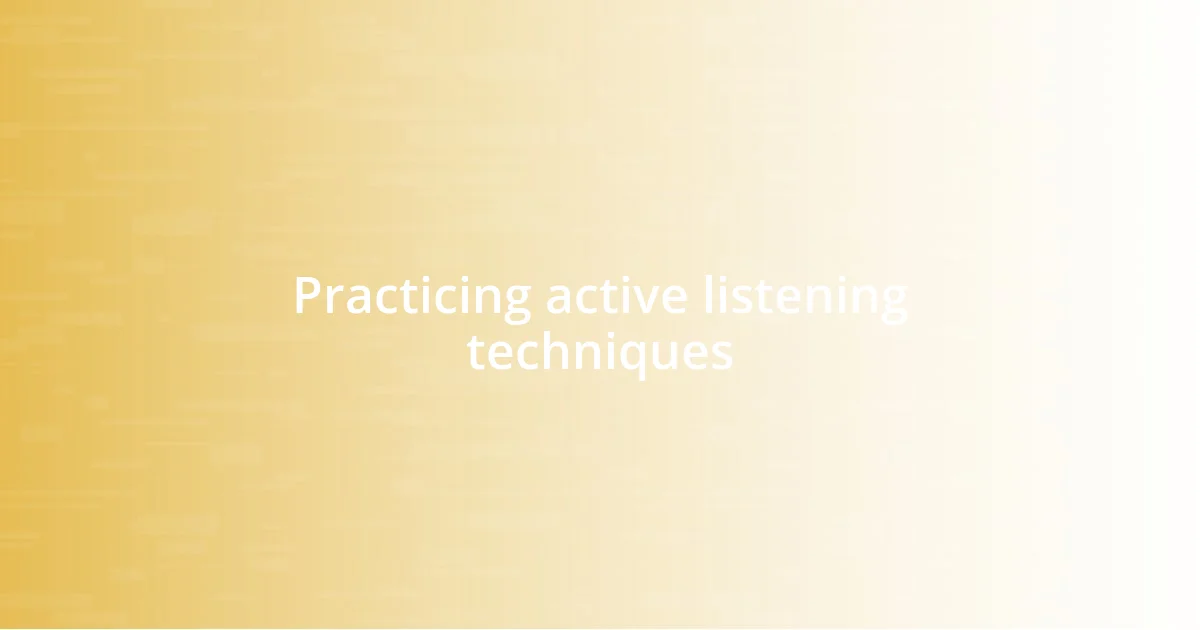
Practicing active listening techniques

Practicing active listening techniques
Active listening might seem simple, but in my experience, it’s a skill that often needs nurturing. I vividly recall a meeting where I struggled to keep my focus while a colleague passionately shared their ideas. Instead of zoning out, I decided to put my phone away and fully engage. By nodding, maintaining eye contact, and summarizing their points, I found that not only did my understanding deepen, but it also encouraged them to speak more freely. It felt rewarding to witness how my attention elevated the conversation, enriching our collaboration.
Here are a few techniques that can enhance your active listening skills:
- Maintain eye contact: Show that you are genuinely interested in what the speaker has to say.
- Reflect back: Paraphrase their message occasionally to ensure understanding and to validate their feelings.
- Pause before responding: Take a moment to absorb what’s said before sharing your thoughts.
- Ask open-ended questions: Encourage elaboration by asking questions that require more than a yes or no response.
- Minimize distractions: Put away your devices and give the speaker your undivided attention.
These methods not only created a productive dialogue in my experiences but also fostered a sense of respect and teamwork. It’s fascinating how small adjustments in our listening habits can transform the dynamics of any collaborative effort. Every interaction becomes an opportunity to strengthen connections and cultivate patience. I can’t stress enough how crucial these techniques have been in my own collaborative journeys.
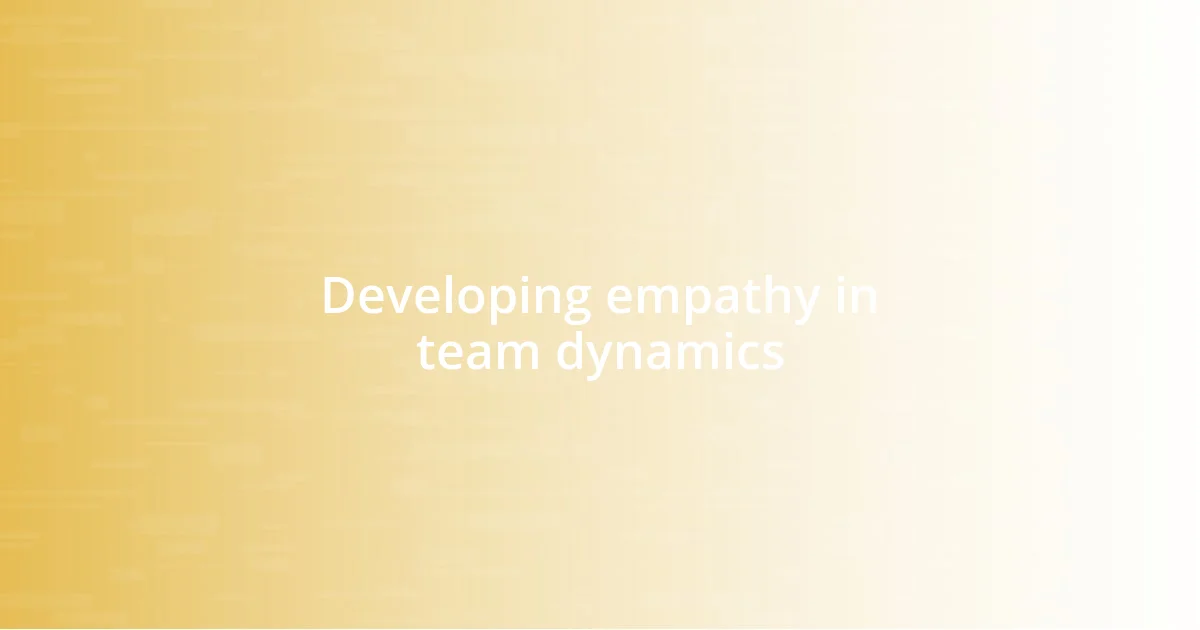
Developing empathy in team dynamics
When I think about developing empathy in team dynamics, I can’t help but recall a project where we faced some serious challenges. There was one instance when a teammate seemed particularly withdrawn during discussions. Instead of assuming they were disinterested, I decided to check in with them privately. I discovered they were struggling with the workload while juggling personal issues. That moment taught me how crucial it is to look beyond surface behaviors. How often do we overlook what lies beneath? Empathy not only fosters stronger relationships but also encourages a safe space for open dialogue.
Reflecting on my experiences, I’ve learned that listening to underlying emotions can be just as important as the words being exchanged. Once, during a tense meeting, I noticed a colleague’s frustration bubbling up, and instead of pushing forward with the agenda, I asked if they wanted to share their thoughts. Their facial expression softened, revealing a wealth of ideas that had been stifled by their emotions. It was eye-opening to see how allowing space for feelings created room for innovative contributions. Isn’t it fascinating how a little patience can unlock creativity?
I also remember a time when I misjudged a teammate’s reaction. They were visibly upset by some feedback, and my initial response was to brush it off as unnecessary sensitivity. However, taking a step back, I realized that their perspective was rooted in genuine concern for the team’s success. For me, this was a turning point in understanding the power of empathy in clarifying intentions. Through this lens, I’ve come to appreciate how approaching collaboration with compassion can bridge gaps, making our collective efforts more fulfilling and productive. Have you found that empathy in your interactions leads to unexpected growth?
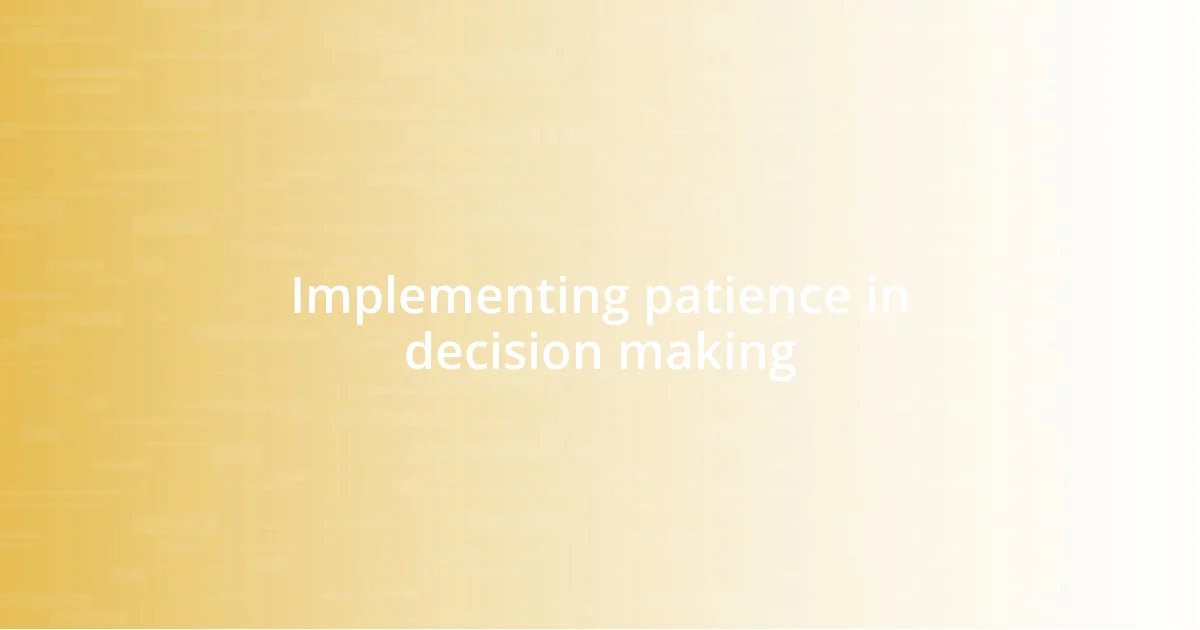
Implementing patience in decision making
When it comes to implementing patience in decision-making, I often find myself in a reflective moment that highlights the necessity of taking a breath. I recall a project where the team rushed into a significant decision without fully considering all viewpoints. As someone who thrives on thorough dialogue, I felt the tension in the room. By suggesting a short break to gather our thoughts, I witnessed how our collective patience led to richer discussions and better outcomes. It was a reminder that slowing down can make all the difference.
I’ve also learned that patience allows for deeper insights to surface. During one brainstorming session, everyone was eager to jump into solutions. I resisted the urge to push forward and instead encouraged my teammates to momentarily focus on the challenges, not just the fixes. This pause revealed unexpected perspectives and highlighted potential pitfalls we hadn’t considered. It’s intriguing how embracing a little stillness can illuminate pathways that a hurried approach might obscure.
In my experience, patience can turn decision-making into a collaborative journey. On one occasion, I watched as a colleague grew increasingly frustrated with our deliberations. Rather than dismissing their unease, I took the time to validate their feelings. This simple act of patience not only diffused the tension but also opened up a dialogue that ultimately aligned our goals. It makes me wonder—how often do we underestimate the power of lingering in discomfort to arrive at a more thoughtful consensus?
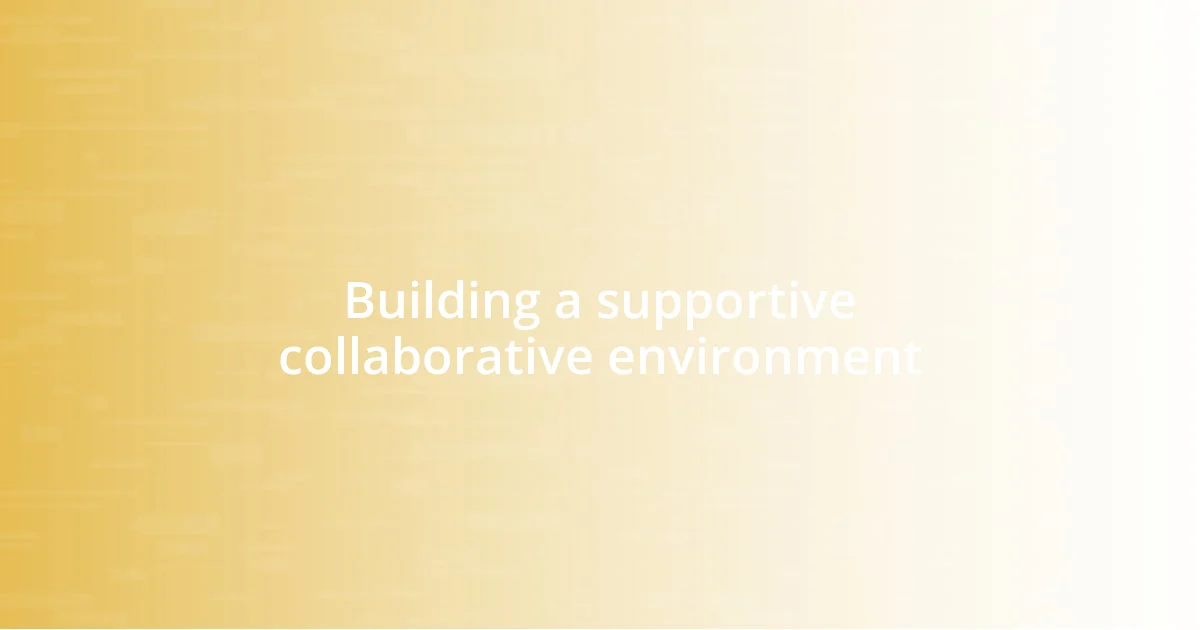
Building a supportive collaborative environment
When I reflect on building a supportive collaborative environment, I remember a workshop where trust was the main focus. We started with a trust fall exercise, and as awkward as it felt at first, it laid the groundwork for openness. Seeing my colleagues take that leap of faith, literally and figuratively, made me truly appreciate how vital it is to create a space where everyone feels secure enough to share their thoughts without fear of judgment. Have you ever felt that shift when trust is present?
There’s something deeply powerful about fostering a culture of appreciation within a team. I once had a colleague who made it a point to express gratitude after our meetings. It may have seemed small, but it transformed our environment. When I started doing the same, I noticed a palpable shift in attitude; people felt more valued and engaged. Isn’t it remarkable how a few words of recognition can bond a team together?
Sometimes, it’s crucial to set aside time for casual check-ins. I remember scheduling informal coffee breaks with my team instead of just work-related discussions. These moments led to genuine conversations and shared experiences, which strengthened our connections. By prioritizing these interactions, I’ve seen how they cultivate camaraderie and make collaboration not only more effective but also enjoyable. Couldn’t we all benefit from a little more connection during our busy days?
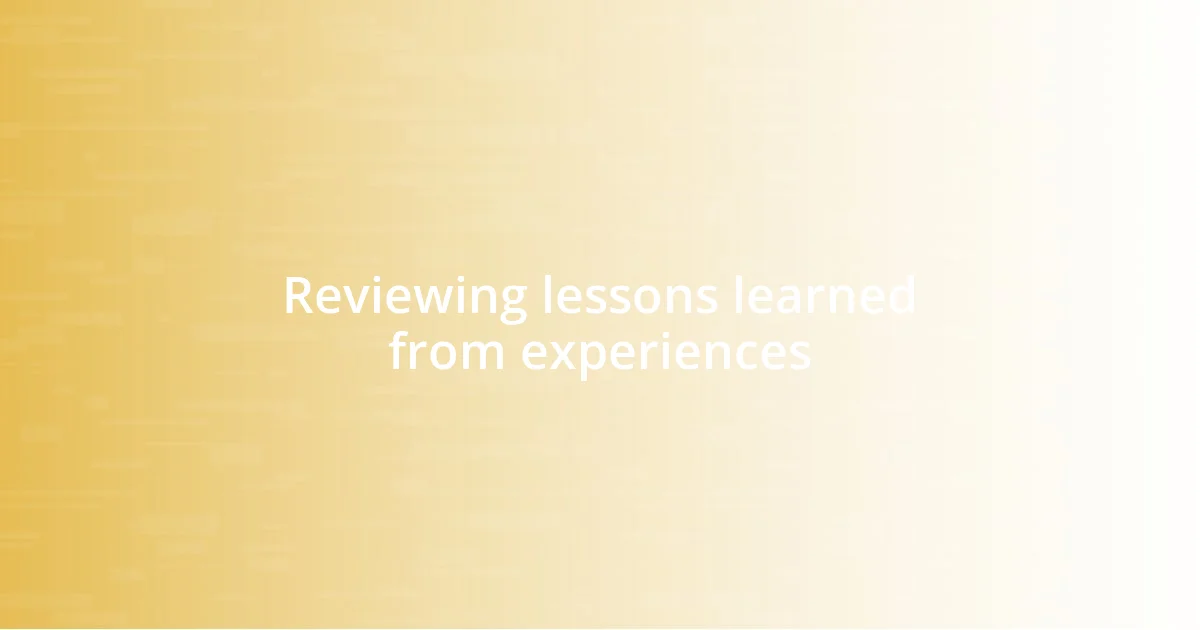
Reviewing lessons learned from experiences
Reflecting on my experiences, I’ve realized that each collaborative venture brings its own set of lessons. I vividly recall a time when our team faced a tight deadline, and tensions were high. Instead of diving headfirst into a flurry of activity, I suggested we take stock of where we stood. That moment of pause was enlightening—it allowed us to rediscover our objectives and adjust our approach, leading to a more focused effort. Have you ever taken a step back to see the bigger picture amidst chaos?
In another instance, I learned that the art of patience goes hand-in-hand with empathy. Early in my career, I worked on a project with a particularly detail-oriented colleague. At times, I felt their pace was slowing us down, but when I stopped to listen to their concerns, I discovered they were safeguarding our quality standards. This experience taught me that patience isn’t just about waiting; it’s about understanding. How often do we rush past valuable perspectives that could enhance our work?
One memory that stands out is a project where we encountered unexpected roadblocks, and the initial reaction was frustration. Rather than allowing that frustration to fester, I urged the team to share their feelings first. This openness turned what could have been a blame game into a chance for problem-solving together. As we navigated those challenges with patience, I found that not only did our solutions improve, but our bond strengthened significantly. Isn’t it fascinating how addressing emotions can lead to innovative outcomes?










